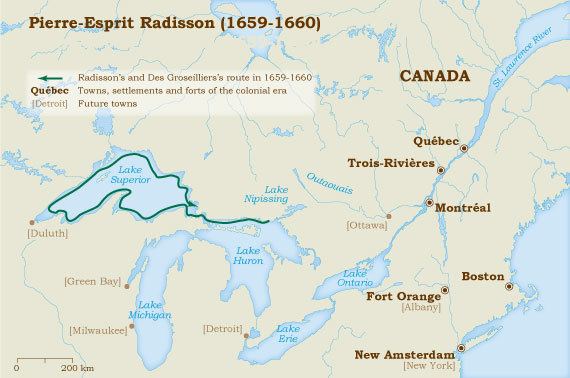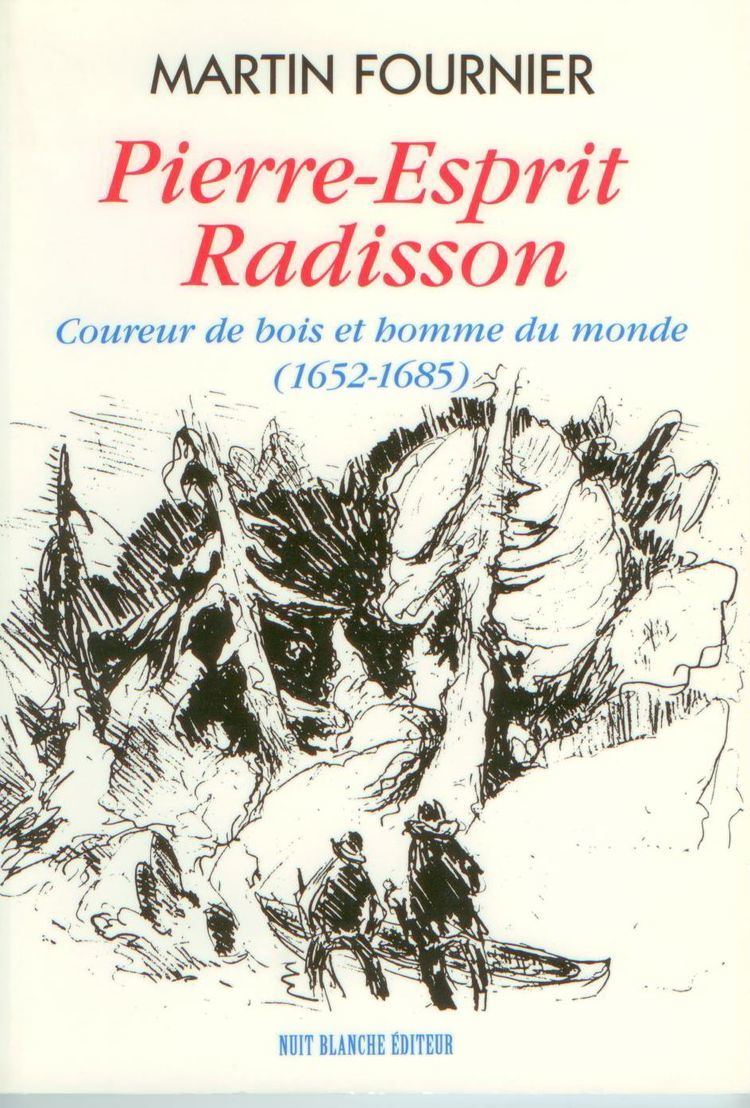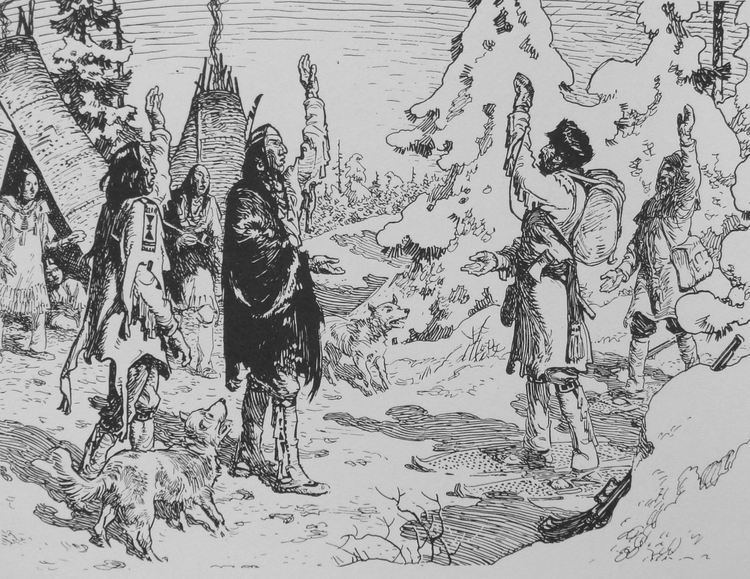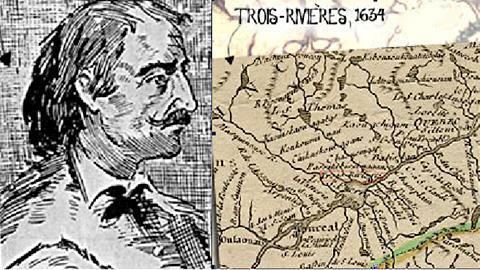Name Pierre-Esprit Radisson | ||
 | ||
Died 1710, London, United Kingdom Books Voyages of Peter Esprit Radisson Similar People Medard des Groseilliers, Prince Rupert of the Rhine, Rene‑Robert Cavelier - Sieur de, Samuel de Champlain, Charles II of England | ||
Pierre-Esprit Radisson (1636/1640–1710) was a French fur trader and explorer. He is often linked to his brother-in-law Médard des Groseilliers. The decision of Radisson and Groseilliers to enter the English service led to the formation of the Hudson's Bay Company. His career was particularly notable for its repeated transitions between serving Britain and France.
Contents
- Birth and immigration to New France
- Capture and life with the Iroquois
- Departure from the Iroquois and missionary work
- Career
- Trade and journeys to Hudson Bay
- Foundation of the Hudsons Bay Company
- In French service
- Working for the Hudsons Bay Company
- References

Birth and immigration to New France

The location and date of Pierre-Esprit Radisson's birth are not specifically clear, though the most widely accepted consensus seems to place his origin in the lower Rhone region of France, likely near the town of Avignon, sometime in the mid-seventeenth century. An affidavit from 1697 and a petition from 1698 contain statements from Radisson himself indicating that he was 61 and 62 years old respectively, which would place his year of birth at 1636. However, a 1681 census of New France indicated that he was, at the time, 41 years old, placing his birth year instead at 1640. In Radisson's own writings, he claims that his family, the Hayet-Radissons, originally stemmed from the town of St. Malo. However, records seem to suggest that his family more likely came from either Paris or Avignon. Baptismal Records from Carpentras, a city near Avignon, concerning Radisson's father ( Pierre-Esprit Radisson Sr.) provide evidence in support of the latter option. As Radisson himself describes in his writings, he immigrated from France to Canada on the 24th of May, in 1651. Information regarding Radisson's arrival in New France is scarce, but it is theorized that he arrived with, or as a result of, his half-sister (from his mother's side) Marguerite Hayet. It is also unknown whether or not he arrived alongside other members of his family, namely his two sisters Élisabeth and Françoise. Regardless, by 1651, Marguerite, who would go on to marry Radisson's eventual fur-trading partner Médard Chouat Des Groseilliers, was living in Trois-Rivières at the same time as her three half-siblings.
Capture and life with the Iroquois

According to Radisson's account, in the same year (though perhaps a year later in 1652) he had been hunting fowl with several other men near his home in Trois-Rivières when he was captured by the Iroquois. Initially a petty squabble had separated him from his friends and by the time he had found them, they had been killed by a Mohawk raiding party. Citing his youth as the reason he was left alive, Radisson claims that the Iroquois, after immediately capturing him, treated him relatively kindly and that he, partially by showing an interest in Mohawk language and culture, was assimilated into a local Mohawk family who had settled near modern day Schenectady in New York state. This assimilation was the custom for the Mohawk, who often replaced people lost to disease and warfare and adopted young captives from other tribes and European nations. After approximately six weeks of gradual integration, Radisson's assimilation and partial adoption of Iroquois nationality was largely solidified.

However, shortly thereafter, while out hunting with three Iroquois, Radisson reluctantly agreed to attempt escape after meeting an Algonquin man who offered to help him return to Trois-Rivières. After successfully killing Radisson's Iroquois companions, Radisson and the Algonquin man travelled for 14 days until they were within sight of Trois-Rivières, but were recaptured by patrolling Iroquois shortly before reaching the town. The Mohawks killed the Algonquin and subjected Radisson, along with approximately 20 other prisoners, to ritual torture, but much of his punishment was lessened as a result of the advocacy of his adopted Mohawk family. Radisson had his fingernails pulled out and one of fingers cut to the bone while being forced to watch ten Huron Indians being tortured to death; Radisson was spared death as his adopted parents gave gifts as compensation to the families of the men he had killed. While his fingernails were being pulled out, Radisson was forced to sing. Radisson's adopted parents told him that he would must be brave for the next several days as the Iroquois despised cowards, and if he showed fear, he would be killed. At the same time, the Iroquois liked to eat the hearts of brave men out of the belief that one could acquire their courage, so Radisson was warned to be only moderately brave. The day after his fingernails were pulled out, Radisson was tied to a scaffold, and not knowing of his fate, was first burned by an old and then had an young man force a red-hot dagger though his foot. Throughout it all, Radisson displayed much stoicism, knowing his life depended upon being brave.

After three days of being tied to the scaffold and being repeatedly burned and stabbed, the Iroquois brought out a group of Huron prisoners, and Radisson watched as some of them had their heads smashed in with tomahawks while the rest were proclaimed to be Iroquois who were now to be adopted by Iroquois families. Eventually he was released, and, overwhelmed with relief, described the experience as a moment in which "all my paines and griefs ceased, not feeling the least paine. [My father] bids me be merry, makes me sing, to wich I consented with all my heart." Knowing that it was adopted parents-who by his account very much loved him-who saved him from executed, Radisson described feeling a deep sense of gratitude to his adopted parents who limited his punishment only to being tortured. The Canadian historian Martin Fournier noted that by Iroquois standards Radisson had not been tortured that badly as they only pulled out his fingernails and burned him, which suggested that he was meant to survive this ordeal.

Afterwards, following the healing of his torture wounds and a subsequent 5 months war-party expedition, Radisson departed for a trading trip, alongside other Mohawk warriors, at Fort Orange.
Departure from the Iroquois and missionary work

Upon arriving at Fort Orange (present-day Albany, New York), then controlled by the Dutch, he was recognized as a Frenchman and offered freedom by the local governor, who was willing to pay his ransom. Radisson initially refused but, after returning to the Iroquois village, later regretted the decision and escaped "at 8 of the clock in the morning" on the 29th of October, 1653. Returning to Fort Orange once more, he met a Jesuit Priest, Joseph Antoine Poncet, who made him "a great offer." Radisson never elaborates on what that offer entails other than the fact that it required him to return to Holland in early 1654, though it likely referred to missionary work. He returned to Trois-Rivières later that year and, over the next three years, embarked on several missionary expeditions. These interim years were largely ignored by Radisson in his own writings and little is known about his whereabouts during the period other than the information provided by a Deed of Sale signed by him in November of 1655. In 1657, Radisson accompanied a joint Franco-Huron-Iroquois expedition into the territory of the Onondaga Iroquois, attempting to more thoroughly establish a Jesuit mission in the area and promote further fur trading. The expedition ended in 1658 after rising tensions with local Iroquois caused the French to flee rather abruptly. Radisson returned to Quebec soon thereafter.
Career
Radisson's biggest impact in Canadian History came from 1658 to 1684, when he was an active coureur-des-bois, fur trader and explorer. In August of 1659, Radisson convinced his brother-in-law, Médard Chouart des Groseilliers, to hire him for his journey around Lake Superior. The reason for the year long trip was to collect furs, in order to participate in the ever-lucrative fur trade.
In the winter of 1659-1660, Radission and Des Groseillers lived just south of Lake Superior in what is now Wisconsin, associating with groups of Huron, Ottawa, Ojibwa and Sioux Indians. When Radisson arrived at an Ojibwa village on the shores of Lake Superior, where he spent much of the winter, he gave three types of presents to the men, women and children of the village. Radisson wrote that to the men he gave "...a kettle, two hattchets [tomahawks], and six knives and a blade for a sword", to the women "...2 and 20 awls, 50 needles, 2 gratters [scrapers] of castors, 2 ivory combs and 2 wooden ones, with red painte [vermilion], 6 looking-glasses of tin", and to the children "...brasse rings, of small bells, and rasades [beads] of divers colors...". The American history Bruce White wrote that Radission and Des Groseillers did not entirely understand Ojibwa society as the kettles were used more much by the women than by the men while the gift of paint and make-up for the women ignored that the fact that Ojibwa men used make-up and painted their faces just as much as Ojibwa women did. Kettles played a prominent role in the Huron holiday of the Feast of the Dead, and Radisson appears to have believed that the Ojibwa men would appreciate the gift of a kettle for their own version of the Feast of the Dead. On the other hand, White noted that the two Frenchmen clearly understood some aspects of Ojibwa gender very well, as the gift of tomahawks for the men reflected that Ojibwa men were hunters and warriors while the gift of awls for the women reflected that Ojibwa women gathered rice, gardened, cooked, fished, built bark houses, and wove mats. Ojibwa women played important roles in the fur trade, and often used their sexuality as a way of establishing long-term relations, so to speak, with the French in order to ensure the continued supply of European goods and prevent the French from trading with other Indians. Radisson reported on visiting one Ojibwa village in the spring of 1660, there was a welcoming ceremony where: "The women throw themselves backward on the ground, thinking to give us tokens of friendship and wellcome [welcome]". Radisson was confused at first by what was meant by this gesture, but as the women started to engage in more overtly sexual behavior, he quickly realized what they were offering. Several tribal elders informed Radisson that they did not want him trading with their enemies, the Dakota [Sioux], and that he and Des Groseillers were free to sleep with the unmarried women of the village just as long as they did not trade with the Dakota. As Radisson's account was written for an English audience, he left it rather vague about whatever he and Des Groseillers took up this offer or not.
The return of Radisson and Groseillers to Quebec on August 24, 1660 was received with joy by the merchants who were waiting on them, to return to Europe but was received with jealousy from the Governor. In 1659 Groseillier had gone to Governor d'Argenson to demand the year-long permit to explore New France, and had it granted to him and his crew. Seeing the success of the trip and the number of furs they had brought back, d'Argenson levied high taxes on them, as they had been gone for a couple of days past their year-long permit. After a number of unsuccessful attempts in the courts to regain what had been confiscated from them by the Governor, Radisson and Groseillier decided to base themselves out of Boston in the British Thirteen Colonies for their next explorations.
Trade and journeys to Hudson Bay
Throughout their 1659–1660 voyage, the French explorers kept hearing of the "salt sea" as an area with an abundance of good furs. The "salt sea" they determined must be Hudson Bay and so looked for financing and sea-going ships for their new explorations. What was different between their approach to the trip was they would reach it from outside of the continent, instead of through a number of internal rivers. The first voyage to Hudson Bay was unsuccessful, the winter of that year came too quick, and the rations on board wouldn't be sufficient for the winter. They were forced to make their way back to Boston but were promised two ships and crew for a second attempt the following year. This second attempt however never occurred due to one of the ships being destroyed in a storm, and the two being invited to King Charles II's in 1665. There they passed the winter, and in the spring leave for New World with ships crew that had been promised to them by the King. The Eaglet, which was carrying Radisson to Hudson's Bay was almost sunk in an Atlantic storm and was forced to turn back to Plymouth to avoid sinking. In September 1668, the Nonsuch landed in the Rupert river region on the shores of James Bay, where Des Groseillers used his knowledge of frontier living to build dwellings to allow the crew to survive the winter. About 300 Cree Indians came up in the spring of 1669 to trade furs in exchange for European goods. Radisson sought the support of a royal patron to secure a crown monopoly on trade with in the Hudson's Bay region, and found one in the form of Prince Rupert of the Rhine, the king's first cousin and a war hero on the royalist side during the English Civil War. Prince Rupert was not considered to be a good businessman and was not of the king's closest friends, but as the only member of the royal family prepared to champion the Radisson-Des Groseillers project of fur trading on the shores of Hudson's Bay, he was their only hope of getting a royal charter from Charles II. Radisson and des Groseillers in their dealings in London to receive financing from the City had the advantages of being the only men who how to survive in the north, the various First Nations languages and customs, and about the geography of the interior of North America, much of which was a mystery in Europe at the time.
Foundation of the Hudson's Bay Company
In 1670, Radisson was back in England and on May 2, received a royal charter giving him and his partners the exclusive rights to the land surrounding Hudson Bay, ultimately founding the Hudson's Bay Company. The next few years are filled with a number of highly profitable trips between England and the Bay region. King Charles II in his charter for the Hudson's Bay Company founded a proprietary colony named Rupert's Land declaring that the lands adjutant to Hudson's Bay or rivers flowing into Hudson's Bay now belonged to the Hudson's Bay Company. In theory, much of modern Canada now belonged to the Hudson's Bay Company as Rupert's Land was a vast region, but in practice, the company only had a few forts on the sea coasts of northern Ontario and northern Quebec, to which were later added forts on the sea coast of Manitoba. It was not until the late 18th century that the Hudson's Bay Company showed any interest in moving inland and making good its claims to control Rubert's Land.
Both Radisson and Grosseiliers operated within the Hudson's Bay Company with the support of Prince Rupert and the Company's director Sir John Robinson. Radisson and Grosseiliers were successful in having the Company receive much capital from the City in order to fund its operations. In 1672, Radisson married Mary Kirke, the daughter of Sir John Kirke, one of the City investors in the Hudson's Bay Company. As anti-French and anti-Catholic sentiment increased in England following discontent expressed in events such as the Bawdy House Riots of 1668, both Prince Rupert and Sir John decreased their support for the men. Although Radisson's reasons for doing so are not fully clear, he finally left London in 1675 with Grosseiliers to reenter the service of France, leaving his wife behind in England.
In French service
After leaving Britain, Radisson found himself unpopular in the royal court. In 1677 he decided to join the navy and to fund Jean II d'Estrées' expedition in the Franco-Dutch War to conquer the island of Tobago, winning the man's favor. Following his involvement in the war, he borrowed 100 Louis d'or from the Marshall in a failed attempt to pay to bring his wife back from Britain, and subsequently failed to regain a position in the Hudson's Bay Company, as a further result of anti-French prejudice.
In 1681 Radisson headed out to found a fort on the Nelson River under a French flag, albeit against the wishes of the French state. He did so as a means of capturing the market, fearing the construction of a British fort on the same river and thus further dominance of the bay by the Hudson's Bay Company. He recruited Grosseiliers the following year to build a more permanent base.
In the winter of 1683 he and Groseilliers went to France to deal with their legal problems. (They had seized two English parties in time of peace and paid Quebec tax on furs from Hudson Bay from their Nelson Rivert fort, which may not have been part of Canada.) Here they found themselves pawns in the events that led up to the Glorious Revolution. The English ambassador, Lord Preston, asked that they be punished. Compromise plans were made to send Radisson back to the Bay to pick up the remaining furs and divide the profits fairly. Lord Preston seduced Radisson back into the English service and Groseilliers returned to Quebec.
Working for the Hudson's Bay Company
In 1684 he sailed for the Hayes River in the Happy Return, where he found Groseilliers' son Jean-Baptiste conducting a brisk trade with the Indians. He talked Jean-Baptiste into the Hudson's Bay Company service and left for England in September, leaving John Abraham in charge of the fort. (Eight days later two ships belonging to Chesnaye arrived from Quebec. Although there was conflict, no blood was shed. The French wintered near the English and returned to Quebec with a moderate load of furs.)
In 1685 he was made 'Superintendent and Chief Director of the Trade at Port Nelson,' where he seems to have accomplished little. In 1687 he made serious charges against the superintendent of York Factory. The HBC rejected the charges and Radisson was removed. Thereafter he lived in England on an HBC pension which was irregularly paid. He died in 1710. In 1729 the company voted ten pounds to his third wife, "she being ill and in great want."
Radisson wrote his Voyages in 1668 or 1669 in England after a storm prevented him from joining the first expedition into Hudson Bay. The original has been lost but an English translation was found among the papers of Samuel Pepys and now resides in the Bodleian Library. Its reliability as a historical source is contentious.
